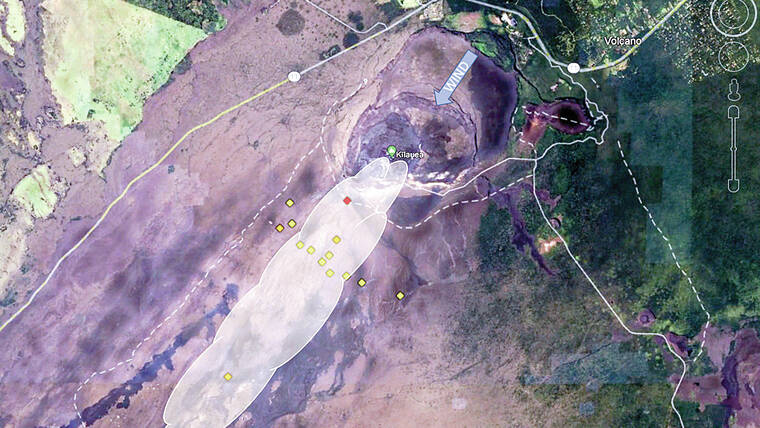Volcano Watch: Measuring volcanic gases: The answer is blowin’ in the wind
Measurement of volcanic gases is critical for both public safety and understanding volcanic activity — and everything we measure relies on the wind.
The USGS Hawaiian Volcano Observatory currently operates 19 permanent gas monitoring stations, and 7 portable instruments for eruption response. These can be divided into two categories based on what they measure: (1) gas concentrations; and (2) emission rates.
ADVERTISING
Gas concentration instruments include multi-GAS stations that measure a combination of gases (CO2, H2O, SO2, and H2S) and high-resolution stations that can measure a single gas (SO2) down to very low concentrations. These instruments draw in or ‘sip’ samples of volcanic plume to tell us which gases are present and the ratios of these gases to each other, which is important for understanding the volcanic system.
Emission rate instrumentation, which includes the innovative Flyspec Array, UV-camera, and the vehicle-mounted DOAS, measures the plume’s absorption of ultraviolet light from the sun via remote sensing. This allows us to determine how much SO2 is coming out of the volcano, though only during daylight hours.
All these instruments require cooperation from the gases themselves: the plume must pass by or over the instrument for a measurement to be made.
The volcanic plume, however, doesn’t move on its own. It relies on the wind to carry it in any given direction. The job of volcano gas scientists is to chase around and measure this shifting, transient blob of gas—this is not an easy task!
Imagine a scenario where seismometers didn’t work every time it rained. Perhaps because the ground becomes too squishy and dampens the seismic signals. That’s not really what happens, but let’s pretend. In this scenario, we’d be able to feel an earthquake and know when it happened, but we’d have no way of measuring its magnitude just because the ground is wet. Thankfully, in the real-world, seismometers work no matter the weather condition — but gas instruments do not. They need the wind to be in right direction and the right speed to make a useful measurement.
At Kilauea volcano, the dominant trade winds mean that near-surface winds blow from the northeast most of the year. For this reason, HVO’s permanent gas monitoring stations are positioned to the southwest (downwind) of Halema‘uma‘u, Kilauea’s summit crater.
If the wind direction is reversed relative to normal trade winds (a condition we call “Kona winds”) then although we can see the plume, smell it, and even taste it, we have no easy way of measuring it because the wind is blowing the gas away from our permanent sensors.
Similarly, if the wind is too slow (below about 4 m/s, which is 9 mph or 8 knots), then the plume can loft straight up and once again miss our sensors. Alternatively, if the wind is too strong then it effectively dilutes the plume, spreading it thin and making it difficult for our sensors to measure. How strong is too strong depends on how much gas is in the plume, but during inter-eruptive periods with relatively little gas the cut-off is around 12 m/s, which is 27 mph or 23 knots.
Another complication is that volcanoes don’t always erupt from the same location. In the most recent eruption at Kilauea, fissures opened in the upper Southwest Rift Zone — downwind of nearly the entire gas monitoring network. Only one instrument, a high-resolution station called HRPKE, was located near the eruptive vents, a few hundred meters to the west/northwest of the fissures. However, the winds were northerly that day, and were blowing the thick eruptive plume to the south, away from HRPKE. It didn’t record a wisp of gas until several hours into the eruption when the wind turned more easterly, finally blowing the plume to the station.
Effective gas measurements require an alignment of four things: wind direction, wind speed, sometimes daylight, and always luck. Volcano gas researchers at the USGS continue to develop new technologies to help us win this sophisticated game of chase, so that we can inform the public about this ever-shifting volcanic hazard. So, if you check the public webpage and it looks like there isn’t any gas reported, it may just mean the wind is not cooperating and we’re still chasing down the plume.
Volcano activity updates
Kilauea is not erupting. Its USGS Volcano Alert level is ADVISORY.
Elevated earthquake activity and inflationary ground deformation rates continue in Kilauea’s summit region, indicating that magma is repressurizing the storage system. Over the past week, about 650 events (most were smaller than M2) occurred beneath Kilauea’s summit region and extending southeast into the upper East Rift Zone. Unrest may continue to wax and wane with changes to the input of magma; changes can occur quickly, as can the potential for eruption. The most recent summit sulfur dioxide emission rate measured was approximately 100 tonnes per day on July 17, 2024.
Mauna Loa is not erupting. Its USGS Volcano Alert Level is at NORMAL.
Two earthquakes were reported felt in the Hawaiian Islands during the past week: a M2.8 earthquake 6 km (3 mi) S of Volcano at 1 km (1 mi) depth on July 16 at 3:33 a.m. HST and a M3.0 earthquake 2 km (1 mi) SSE of Pahala at 33 km (20 mi) depth on July 12 at 5:50 p.m. HST.
HVO continues to closely monitor Kilauea and Mauna Loa.
Please visit HVO’s website for past Volcano Watch articles, Kilauea and Mauna Loa updates, volcano photos, maps, recent earthquake information, and more. Email questions to askHVO@usgs.gov.





